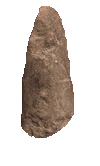

|
The Mesolithic hunter-gatherers way of life carried on virtually unchanged until around 4,000 BC, when evidence of the first farming appears on archaeological record, the time period from 4,000 BC until 2,200 BC is usually referred to as the Neolithic or the New Stone Age. With the advent of agriculture the first permanent communities appeared on the landscape. Although these people were farmers, they had not as yet; worked out the finer details of crop management, so every 10-20 years the land would reach the point where it could no longer support crops and the group would simply to move on. Each group, probably no larger than an extended family, seems to have moved around a fairly small region in this way; packing up when the land would no longer produce. With increased knowledge, a growing number of the nomadic bands left their precarious way of life and began to establish more permanent settlements. They settled on the easily drained soils of the upland hills and on the coastal plains, avoiding the thickly wooded valley bottoms. This meant that the areas of heaviest settlement were the hills of the south and west, where many of their remains can be seen today.
They would have started by clearing an area of forest using flint axes, a blade from one such axe has been discovered near Rackleigh, Worlington. It measured about 5 inches in length, was tapered, and had a cutting edge that was 3 inches wide. Once clearings had been made, wild animals, including cattle, sheep, and pigs, were attracted by the grass that grew there, and gradually, over many hundreds of years, they became domesticated. As these settlements became more permanent, they gradually became enclosed by hedges, banks, fences, or ditches. Aerial photography has identified a small number of possible settlement sites around Witheridge; there are signs of enclosures near Woodington and Stourton Barton (Thelbridge), as well as at North Coombe (Templeton). However none of these sites has yet been subject to any investigation on the ground, so their date cannot be confirmed. Better quality flint from South Devon, or even further afield seems to have replaced the earlier, and coarser, chert. It also seems that larger rough lumps were bought in and worked on site to create the required tools. The remains of these lumps have been discovered locally. A scatter of flint pieces picked up at Upcott Farm contained no fewer than 12 cores, which leads one to suppose that there was a settlement in the immediate vicinity. The same location also revealed at least seven scrapers, and three arrow heads have also been revealed, whilst single examples have been found near South Coombe (Templeton) and at Bourne Park Meshaw). Other flakes, less easily dated, have been found on the fields at West Yeo Farm. So far, well over 50 pieces have been found, implying a considerable amount of activity nearby. It must be said that neither the sites nor the finds so far mentioned reflect the full extent of prehistoric activity in the Witheridge area. They simply show the places where people, mainly archaeologists, have looked for evidence. There are doubtless many more sites yet to be discovered. Field walking in almost any ploughed field will turn up some pieces of worked flint. The only way a more accurate map of prehistoric activity could be drawn is after systematic field walking of the parish. However, this can only be carried out where the soil is made available: woodland, permanent pasture, rough moorland and built-up areas can not be investigated by this method. The flint scatter at Upcott Farm, apart from the cores and scrapers, also produced three arrowheads. Whereas these could have been made solely for hunting, they would have been equally useful in conflict. One aspect of the Neolithic period is that evidence of warfare between local groups becomes more apparent. This was probably a natural progression: settlement had made possible the accumulation of a greater amount of possessions, animals and, probably more important, land, and so competition for these things became endemic, and often led to violent conflict. The three arrow heads found in the flint scatter at Upcott Farm, whilst they were probably made solely for hunting, would have been equally useful in conflict. Warfare between local groups became a feature of this period, and this was probably a natural progression. Settlement made the accumulation of possessions, animals, and, probably most importantly, land, so competition for these things became endemic and often led to violent conflict. The introduction of metal working from the continent would only have worsened the situation. The first items introduced in about 2,000BC were in Gold and then Copper. Both were too soft to have any great practical use, and were accordingly more likely to have been a mark of status. Previous Last Edited 03/07/2006 Copyright © 2000-2006 Witheridge Unless otherwise indicated on the page in question, the photographic images reproduced on this site belong to the Witheridge Archives, and, as such may not be reproduced for commercial purposes without written permission. However, you are welcome to use any of the photographs belonging to the archive for personal and/or non-commercial use. Any material shown as not being owned by the archive may not be reproduced in any form without first receiving written permission from the owner of the material in question. The illustration of the Axe Head is reproduced courtesy of Devon County Council. |


